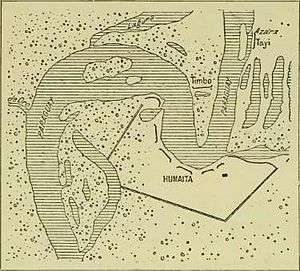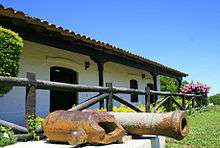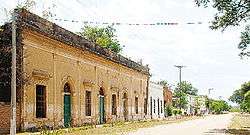Humaitá
See also Fortress of Humaitá; Humaitá (disambiguation)
| Humaitá | |
|---|---|
|
Colonial houses in Humaitá | |
 Humaitá | |
| Coordinates: 27°4′12″S 58°30′0″W / 27.07000°S 58.50000°WCoordinates: 27°4′12″S 58°30′0″W / 27.07000°S 58.50000°W | |
| Country | Paraguay |
| Department | Ñeembucú |
| Founder | February 1778 Pedro Melo de Portugal |
| Government | |
| • Intendente Municipal | Federico Cáceres Delgado |
| Area | |
| • Total | 389 km2 (150 sq mi) |
| Elevation | 44 m (144 ft) |
| Population (2008) | |
| • Total | 3,214 |
| • Density | 8/km2 (20/sq mi) |
| Time zone | -4 Gmt |
| Postal code | 2840 |
Humaitá is a town and distrito on the Paraguay River in southern Paraguay. During the Paraguayan War, it served as the main Paraguayan stronghold from 1866 until its fall in August 1868. During that time, it housed as many as 24,000 troops. Up until March 1868, it was the de facto home of the Paraguayan government.
Portions of the old fortifications, including some large earthworks, are still visible. It also possesses the remains of a Jesuit church dating from the 18th century.
Toponymy
Humaitá comes from the Guaraní words “yma” (meaning antique) and “itá” (meaning stone).
Geography
The predominant geography in the zone is of a sheet of low areas, of whitish land, without prominent waviness. Due to the proximity of the Paraguay River, the increase of the waves overwhelms the whole bordering zone, therefore the geopolitical importance that the city had in the past.
Climate
The climate is tropical, with temperatures reaching 0 °C in winter and 40 °C in the summer.
History
See main article Fortress of Humaitá


The remains of the old fortress of Humaitá are located on the left side of the Paraguay River, approximately 430 km to the south of Asunción. During the Paraguayan War (1864–1870) this fortress was important because it controlled river access to the capital, Asunción.

The defenses of Humaitá were begun by Carlos Antonio López (1790–1862). Built both on water and on land, they dominate a bend in the river. They include two walls with heavily armed bunkers, barracks for troops and officials, ammunition stores, offices, a church, and cemeteries, protected by kilometers of trenches. Mines and chains were used to restrict navigation of the river.
Economy
The inhabitants fish, raise cattle, and practice small-scale agriculture.
Local crafts include vases, gauntlets, pictures in burlap, and articles made from vegetable sponge. Carpets, tapestries, tablecloths, and crocheted apparel are also produced.
Transportation
Humaitá may be reached via Route 1 from Asunción. At San Ignacio, take the detour to Pilar. From Pilar, the route heads southward, going 40 more kilometre on a road without asphalt.
One may also take the bus from Asunción to Pilar and transfer to an interurban bus that serves Humaitá.
Patrimony

The city has a rich historical patrimony. Humaitá was more involved than any other city in the Paraguayan War. The Paraguayan army used this city to contain the invasion by the Alliance. By the end of the war the city had been totally wrecked by the invading troops.
The Cuartel de López, a museum in Francisco Solano López's former barracks, has three rooms where bullets, cannon, stirrups, spurs, swords, and other battlefield relics are displayed.
Tourism
Many tourists visit Humaitá. Students from all over Paraguay come to view the vestiges of the Paraguayan War, as do Brazilian, Paraguayan and Argentine military men and civilians from throughout America and Europe.
- Ruins of Humaitá. Only a few vestiges survived bombardment by enemy cannons during the war. One of these was San Carlos Borromeo's church. Carlos Antonio López ordered its construction. It was inaugurated on January 1, 1861. At the time, it was considered one of the most beautiful in the Americas.
- Itapunta
- Curupayty
- Estero Bellaco
Hotels in the city include the Municipal Hotel, with Italianate architecture, constructed at the end of the 19th century. Many historians believe that Stroessner stayed there during the 1947 revolution.
Restaurants
A restaurant called The Terrace is located in the middle of the town square.
Fishing
Due to its location on the Paraguay River, Humaitá is also a popular place to fish. Fish such as Mandi'i, catfish, piranha, armado, duck, dorado, surubí, and pacú provide the main income of fishermen. Milanese surubí is a popular dish in local restaurants.
Sources
| Wikimedia Commons has media related to Humaitá. |
- World Gazeteer: Paraguay – World-Gazetteer.com * Revista Zeta
